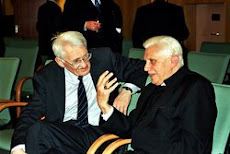In the last post I had promised to elaborate on the following:
"The above (the primacy of implicit knowledge over explicit knowledge) is in no way incompatible with Habermas’ prioritization of conceptual (discursive) over non-discursive (this would ally Habermas with Brandom as against Adorno and McDowell for example). The distinction between implicit knowledge and explicit knowledge is geared towards understanding the conceptual and is not meant as a contrast between mediated and non mediated knowledge."
I have also in mind following comments by Carl Sachs:
"I'd like to use Sellars' distinction, which has become important to Brandom, between sentience and sapience. Let "sentience" refer to reliable differential responses to stimuli. Let "sapience" refer to conceptually structured relations of material inference. (One of the many reasons I like this contrast is that it forces into the open that by "Nature" we do not mean inert matter (hyle, res extensa) but animal embodiment. And one of Nietzsche's great achievements, I think, was to put the question of our own animal embodiment back on the agenda." (full here)
I will try to elaborate my above comments with the help of Brandom's description of his own strategy which in my opinion is very close to Habermas' strategy (despite their crucial differences).
Brandom describes his project in the following terms:
“The overall topic is the nature of the conceptual as such. This choice already entails certain significant emphases of attention: within the philosophy of mind, on awareness in the sense of sapience rather than of mere sentience; within semantics, on specifically conceptual content, to the determent of concern with others sort of contentfulness; within pragmatics, on singling out discursive (that is, concept-using) practice from the background of various other kinds of skilful doing. The aim is to focus on the conceptual in order to elaborate a relatively clear notion of the kind of awareness of something that consists in applying a concept to it – paradigmatically by saying or thinking something about it.” (Articulating Reasons, p. 2).
The methodological decision of giving priority to sapience over sentience requires some explanation. As Brandom puts it:
“One fork in the methodological road concerns the relative priority accorded to the continuities and discontinuities between discursive and nondiscursive creatures: the similarities and the differences between the judgments and actions of concept users, on the one hand, and the uptake of environmental information and instrumental interventions of non-concept-using organisms and artefacts, on the other. We can ask how sharp this distinction is – that is, to what extent and in what ways the possibility of intermediate cases can be made intelligible.” (ibid; pp. 2-3).
Brandom adds that:
“And more or less independently of the answer to this question, it is possible for theorists to differ as to whether they start by describing a common genus and go on to elaborate differentiate (whether qualitative or in terms of some quantitative ordering by a particular kind of complexity), as opposed to beginning with an account of what is distinctive of the conceptual, which is only later placed in a larger frame encompassing the doings of less capable systems.” (p. 3).
Brandom goes on to warn against dangers involved in such methodological choices:
““Theories that assimilate conceptually structured activity to the nonconceptual activity out of which it arises (in evolutionary, historical, and individual-developmental terms) are in danger of failing to make enough of the difference. Theories that adopt the converse strategy, addressing themselves at the outset to what is distinctive of or exceptional about the conceptual, court the danger of not doing justice to generic similarities.” (ibid; p. 3).
Brandom describes his own work as “motivated by a concern with what is special about or characteristic of the conceptual as such. I am more interested in what separates concept users from non-concept user than what unites them.” (p. 3).
Brandom’s strategy of giving preference to sapience over sentience should be seen in this context. Similarly Brandom’s discussion about ‘implicit’ and ‘explicit’ and their mutual relationship should be understood as his attempt to understand ‘sapience’ and has no direct relation with sapience/sentience distinction as such (although obviously there would be an indirect relation with sentience).
Now in this context it is easier to understand Habermas’ concern in his ‘weak naturalism’. Habermas at a meta-level presupposes continuity between sapience and sentience through his background assumption of weak naturalism:
“. . . weak naturalism contents itself with the basic background assumption that the biological endowment of the cultural way of life of Homo sapiens have a “natural” origin and can in principle be explained in terms of evolutionary theory.” (TJ: 27-28).
However having made this meta assumption Habermas’ sole concern is with sapience and not with sentience. Like Brandom he is interested in explaining what is unique about sapience as distinguished from sentience given essential continuity with the sapience and sentience. This is what I believe to be Habermas’ problematic and it requires explanation of human reason in broadly “naturalistic” terms however without reducing sentience to sapience. This is in my opinion the essence of Habremas’ weak naturalism.
Subscribe to:
Post Comments (Atom)





No comments:
Post a Comment